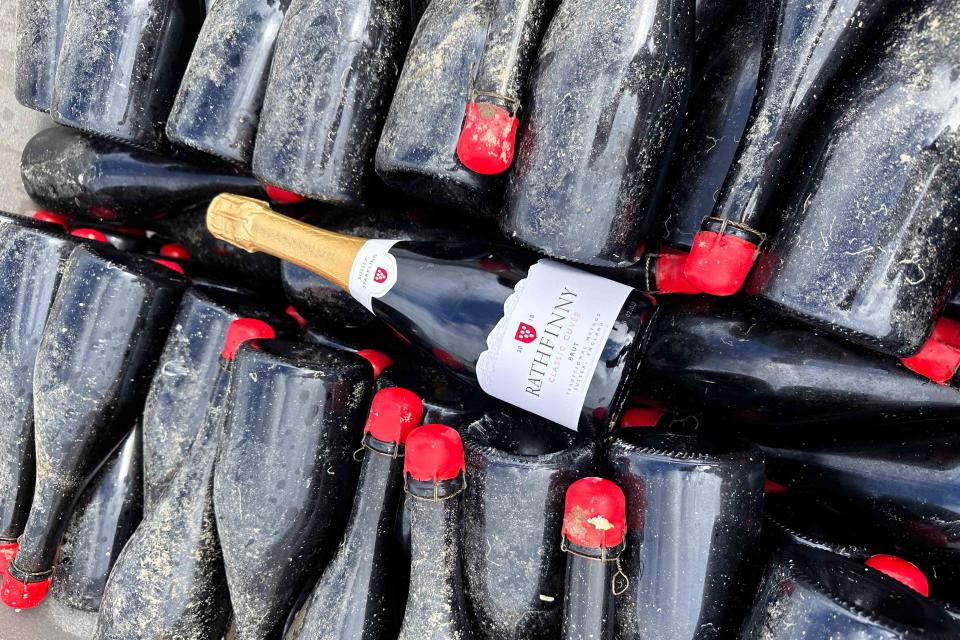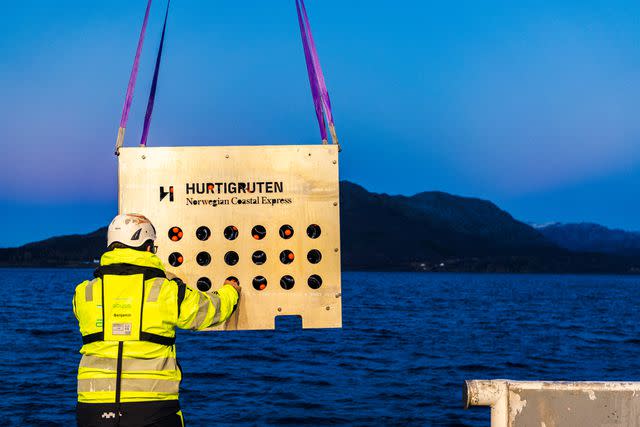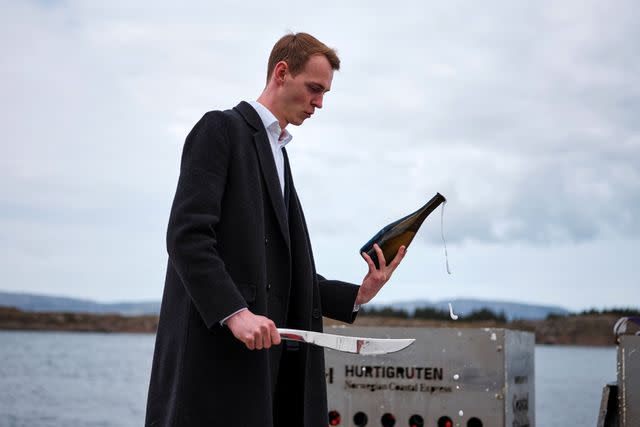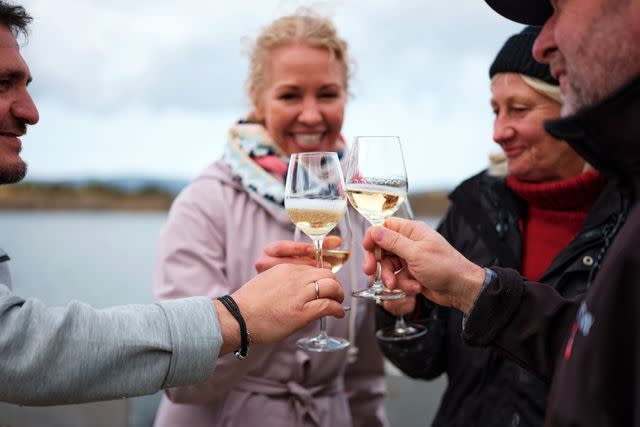1,700 Bottles of Sparkling Wine Were Aged at the Bottom of the Norwegian Sea, and We Got to Try Them
Here's what it tastes like.

Sam Gutierrez
We’ve all heard the expression “aging like a fine wine,” which implies that, like the best bottles, certain things get better with time. But what would happen if, say, that aging took place at the bottom of the ocean in a remote location just shy of the Arctic Circle? That’s the question that Norwegian boating company Hurtigruten wanted to test when it partnered with British Rathfinny Wine Estate to lower bottles of its 2018 Classic Cuveé to the ocean floor in hopes of bringing back a higher-quality, more mature product and, if not, to at least see what would happen.
Earlier this month, the hypothesis concluded after Hurtigruten raised four crates packed with Rathfinny bottles from the bottom of the ocean floor. The bottles had been lowered a total of 111 feet and kept there for six months at temperatures averaging about 41°F. The assumption was that the lack of light, increased pressure, and constant low temperatures would make this location an exceptional sparkling wine cellar. I joined a handful of other international journalists, the local press, the town mayor, and Nikolai Haram Svorte — winner of Norway’s Best Sommelier 2023 — on a boat off the coast of Sandnessjøen, Norway, to witness the raising of the bottles and see where the experiment had led us.
Before we get into how the frigid temperatures altered the bottles, let’s get some background on why Hurtigruten and Rathfinny even dared to risk the bottles at all.
Hurtigruten, a Norwegian shipping company best known as the Norwegian Coastal Express thanks to its first-of-its-kind route that travels all up and down the coast of the country delivering cargo and transporting people, is celebrating its 130th anniversary. To mark the occasion, the company is pulling out all the stops, doing everything from creating a signature cocktail onboard using all Norwegian ingredients to adding new special routes to its arsenal, and, why not, aging some bubbles at the bottom of the sea.

Courtesy of Hurtigruten
The wine-aging idea was the brainchild of Tani Gurra, Director of Beverages at Hurtigruten Norway, who was inspired by recent news stories of bottles found in shipwrecks at the bottom of the ocean and even big-name brands like Veuve Clicquot turning to the sea to alter its products. Additionally, Gurra, who, like the rest of Hurtigruten’s leadership, places great emphasis on using local ingredients and celebrating Norwegian nature whenever possible, wanted to tap into the sea itself as a culinary tool. “We see the fjords as our fish tanks, we see the mountains as our garden for herbs, so why not see the sea as our wine cellar,” Gurra explained.
Given the company’s emphasis on fresh, hyper-local ingredients (the boats pick up bits and pieces from local purveyors like Lofoten Seaweed and Myklevik Gård to use on board as it goes along its route), a collaboration with a Norwegian vineyard would have made sense, but since Norway is not a wine producing country, Gurra and Hurtigruten instead chose Sussex-based Rathfinny Wine Estate for the project. According to Hurtigruten, not only does Rathfinny produce some of the world’s best sparkling wines, but it also works with and considers itself a part of the local community.
Additionally, both companies share an emphasis on sustainability, and Rathfinny is the first sparkling winery in the world to achieve B Corp status — a designation of excellence in the category. Beyond the philosophical alignment, one detail, in particular, made it seem as if the stars aligned on the partnership: Rathfinny’s label features a series of chalk sea cliffs in Sussex known as the Seven Sisters, and coincidentally the spot eventually chosen as the underwater cellar is framed by Norway’s own Seven Sisters mountain range. It was, you might say, kismet.
Equally important as choosing the right wine partner was finding the optimal location to lower the bottles for their deep-sea slumber. Gurra worked with Cristian M. Saether of Cimōrae Caviar, who had himself experimented with aging his lumpfish roe in the ocean, to scout the perfect location for the bottles and find the right team to lower them. The drop site was of the utmost importance; place the bottles on a cliff or uneven surface, as Gurra had initially planned to do, and the currents could cause the crates to tumble and bottles to shatter with them. It was also important to find a site that wasn’t heavily trafficked and that could be kept secret, lest pirates come to plunder the bubbles.
Gurra was so concerned with the well-being of his wax-sealed bottles that he even packed all 1,700 of them into the crates himself because he was afraid anyone else “wasn’t going to do it right.” Not one to wait around and let fate run its course with no oversight for half a year, he also stored some bubbles on the seabed near his home in the Oslo fjord and would pull them out every month to get an insight into how the much colder underwater cellar in Sandnessjøen was doing.

Kristian Dale
After 18 months of dedicating himself to this project, Gurra's excitement was palpable as we watched the aluminum crates being raised with cranes from the sea floor. Framed by the dramatic Norwegian Seven, four crates were painstakingly lifted out of their six-month home on the ocean floor and onto a boat to make their debut. Once the crates were dockside, Gurra did the honors and cracked open one of the crates to reveal the salt-crusted and weathered, but completely intact bottles. Astonishingly, not a single bottle was lost in this experiment, and the only casualty was that the crabs and scallops that made the nooks of the bottles their home had to vacate the premises.
Svorte was on hand to saber open the first bottle. The expectation was that the constant cold temperatures and high underwater pressure would mellow out the sparkling wine and result in a rounder mouthfeel with softer bubbles, but according to Svorte, the wine actually remained quite vibrant.
"To my surprise, the wine has retained more freshness than I anticipated." Svorte continued, "From the refreshing citrus tones to a mineral salty finish, like an oyster, it's clear to me that this hugely intriguing experiment has revealed a unique setting to store and age sparkling wine."

Kristian Dale
The bottles that were not opened to toast the experiment will become the house sparkling wine on board Hurtigruten ships, salty residue and all. But this isn’t the end of the arctic-water-aged wine. Gurra has plans to tap into his underwater cellar again for follow-up experiments, hoping to push the boundaries by aging more bottles for longer periods at lower depths. He’s also not ruling out the possibility of making the bottles available for purchase to those that won’t be taking the scenic route up and down the Norwegian coast any time soon. Though enjoying a glass of Arctic-water-aged bubbly while looking out at the fjords from the floor-to-ceiling windows of a Hurtigruten ship does seem to me the best way to do it.
For more Food & Wine news, make sure to sign up for our newsletter!
Read the original article on Food & Wine.

